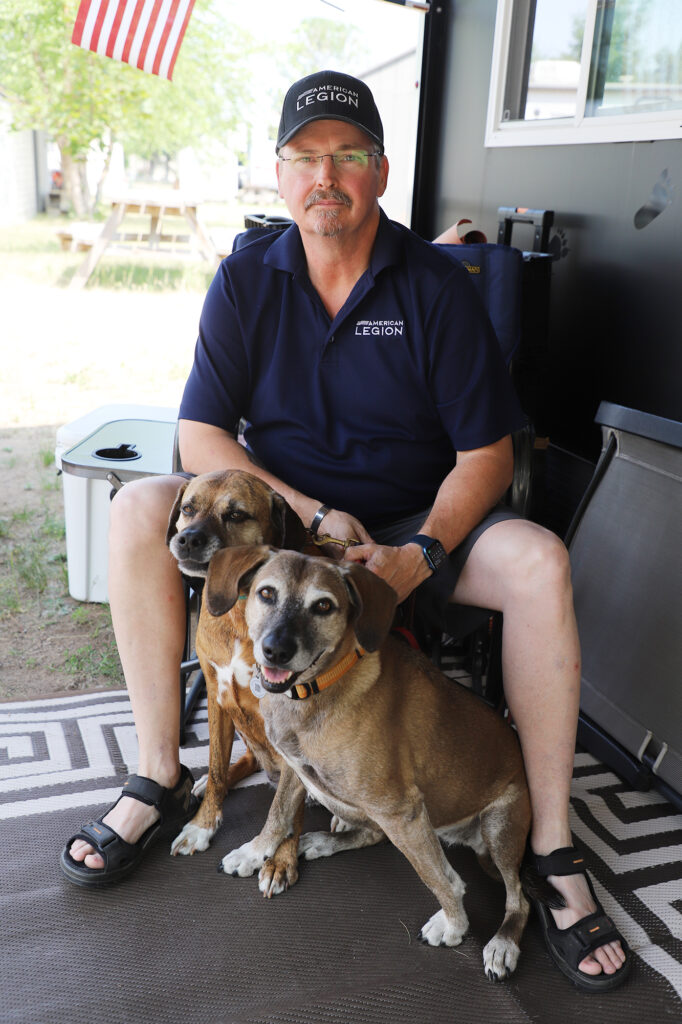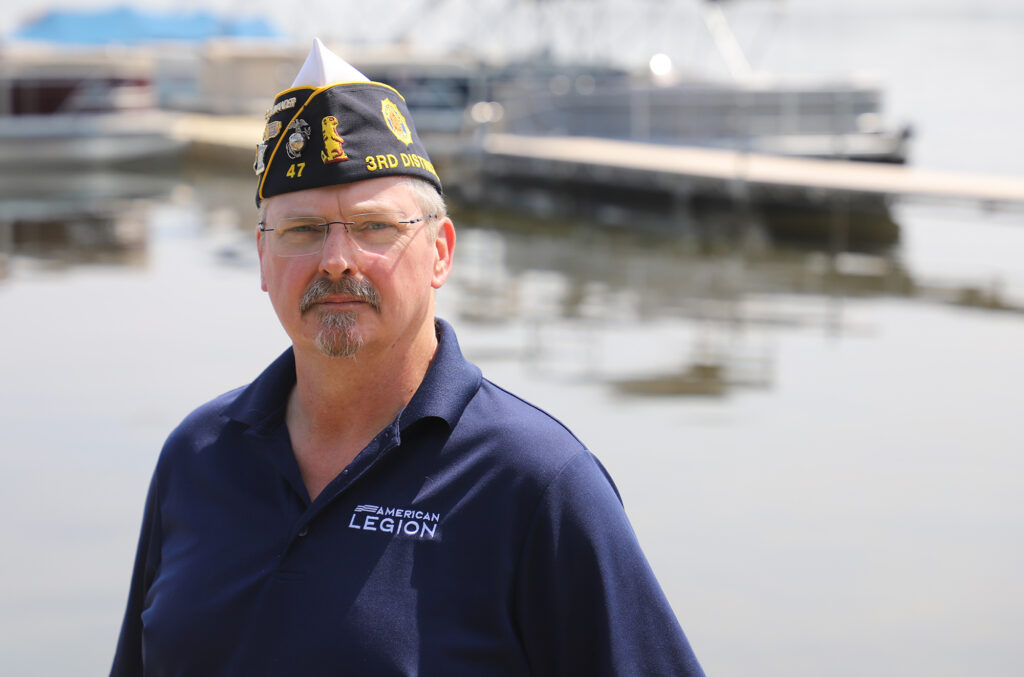From Eagle Scout to Gulf War combat to transition years to Legionnaire

Christopher Anderson always remains a Marine
SCANDIA — Christopher Anderson sometimes wakes up at 2 a.m. with an idea for a video promoting The American Legion.
He hops on the computer and, using the software Final Cut Pro and an image service he subscribes to, he’ll have it done by 4:30 or 5 a.m. or so.
You can see his videos often on the Facebook page for American Legion Department of Minnesota. He is a member of the American Legion Department of Minnesota Media & Communications Committee, better known as the M&C Team.

When Anderson, 53, was interviewed for this story, he, his wife Christine and Department Service Officer Ray Kane were camping together at the Veterans Campground on Big Marine Lake near Scandia. It was the early June weekend of an annual ceremony to retire 15,000 flags. Many veterans from all around come for the program.
“He’s my best buddy,” Anderson said. “I don’t make friends fast. I have a lot of acquaintances and only a few friends. I’ve never been an outgoing person.”
As a kid, Anderson, who graduated from Moorhead High School in 1989, wanted to be a police officer. He earned Eagle Scout at age 14. He was in hockey, soccer and golf. He even played some Legion Baseball.
His uncle had been in the Marines, and he thought he’d follow the same path, seeking to be a military police officer.
“The uniform was so damn cool,” Anderson said. “You want to join the best of the best.”
Commencement was June 5, and the next day he was on an airplane to San Diego, where he went to the Marine Corps Recruit Depot. It was the first airplane ride of his life.
After that, the U.S. Marine Corps sent him up the California shore to Camp Pendleton for advanced infantry training. Then he attended MP school at Lackland AFB. At the time, MPs with the Air Force, Marines and Navy all trained at Lackland. Anderson also got married in 1989.
His duty station ended up being Marine Corps Air Station Beaufort in South Carolina.
A few months later, on Aug. 2, 1990, Iraqi dictator Saddam Hussein ordered his million-man army to invade Kuwait. In October, Uncle Sam sent Anderson and his unit, the 273rd Marine Wing Support Squadron, to Saudi Arabia. They went up to the border with Kuwait and were attached to the 1st Marines Division.
There, they waited. Once Desert Shield became Desert Storm, they watched Air Force and Navy sorties fly over, artillery barrages going north over the horizon, British Harrier jets take off and land straight up and down and Patriot missiles shoot down Scud missiles over their heads.
“I was so glad I had the stars and stripes on my shoulder, and I was not the other guys,” Anderson said.
Anderson carried the M203 grenade launcher on his M-16. When the ground war came, the 1st Marines headed into Kuwait City.
They did some urban fighting house to house. He saw enemy bodies. He may have been responsible for some of those enemy deaths, but it’s not easy to tell for sure with a grenade launcher and the fog of war.
However, most of the time there, he said, was spent performing security and putting flexicuffs on EPWs — enemy prisoners of war. They would work with transportation units to take them to holding areas in the open desert.
And he saw the devastation left on the Highway of Death. It’s a six-lane road in Kuwait called Highway 80 running north out of Kuwait City to the Iraq border, and in Iraq it becomes Highway 8. The other options are either indirect roads or bare desert. When coalition forces were driving Iraqi army out of Kuwait City, it was the most direct motorized retreat for them.
Between Feb 25 and 27, 1991, coalition forces attacked the retreating Iraqi personnel and between 1,400 and 2,000 vehicles. It started by attacking the head and rear vehicles, trapping all others on the road. From there, the destruction lasted 10 hours.
Anderson didn’t view the entire Highway of Death, but he did see the portion nearest to Kuwait City.
“It was a turkey shoot. Everyone called it that,” he said. “You’ll never forget the stench of a burnt body. That’s for sure.”
They weren’t in Kuwait long, he said, before they went back south. The unit went to King Fahd International Airport, where they were checking everyone for contraband.
Back in the States, Anderson met his son for the first time, 5-month-old Christopher Jr.
“I didn’t have a say on the name, and they figured if I didn’t survive the war there would be another me around,” Anderson said.

This was not the age of cellphones and instant communication. Most Gulf War troops had to pen letters home and carried pocket-sized film cameras. They developed the film after returning home.
He got to watch the birth of his son via the modern miracle of videotape — after he got home.
“Two complete strangers got to see the birth of my child before I did,” he said.
Like many veterans, it took time to adjust after combat, death and destruction.
“The military does a great job of treating you for going to war, but they don’t know how to treat you for coming back,” Anderson said.
He left the Marines in 1993, and he and his family moved back to Minnesota. He and his wife split up in 1994, and she gave birth to their second son, Riley, in 1995. He met his current wife, Christine, in 1994 after the divorce, and they began dating in 1995.
They were married in June 1997.
“She’s my rock. She’s seen it all with me over the years. It’s why I’m successful over the years,” he said.
In 1995 and 1996, Anderson went to Interstate Business College to learn autoCAD engineering softball. CAD stands for computer-aided design. The software is key for engineering and machining drafting and creation.
He moved to Wyoming first to work for a mining corporation, then was recruited away to work for an environmental firm in Colorado. He worked for the city of Bloomington in 1998 doing design work and inspecting. He lived in Richfield at the time, and he joined Bloomington VFW Post 1296 in 2009. He served as commander of it in 2012.
“My wife told me to get out of the house and join the VFW to spend some time with other veterans,” Anderson said.
Later, he was with VFW Post 5555 in Richfield. He joined Richfield American Legion Post 435 in 2014.
Today, he works for Dakota County as a senior engineering technician. He’s been there for 19 years. He runs the county lab in Empire Township, where he tests concrete and other materials. He and Christine live in Hastings. He was the commander of Hastings American Legion Post 47 until mid-June.
“I like thriving, active posts,” he said. “I just slid from 1st vice commander to commander when the commander of ourpost had a health issue and had to step down.”
Having been involved in both the Legion and VFW, he said he is turned off by some — not all — VFW members thinking the VFW is “superior” to other organizations because its members have deployed to combat zones or served in hostile waters. In the Legion, any veterans who have served anytime since Dec. 7, 1941, may join. (Of course, both require honorable service, too.)
He remains a member of both organizations and likes when they work well together.
In April 2022, Anderson went to Minnesota American Legion College at Camp Ripley and became excited about all that the Legion does for veterans. He learned the Four Pillars, conflict resolution, how to write resolutions, how to run a meeting and how to mentor new members.
“It made me want to become a better Legionnaire,” he said. “It was good being around like-minded people.”
He met then-1st District Commander Mike Parry and Past Department Commander Mike Ash, who witnessed his electronic skills and video-making capabilities. He became a member of the Department of Minnesota Media & Communication Committee at the 2022 Department Convention in Willmar.
As part of the committee, Anderson met Kane, who was on the M&C Committee at the time and now is the department service officer. Kane now is a member of Anderson’s post, too.
At the 104th Department Convention in Redwood Falls this month, you no doubt will see the duo running around together.


